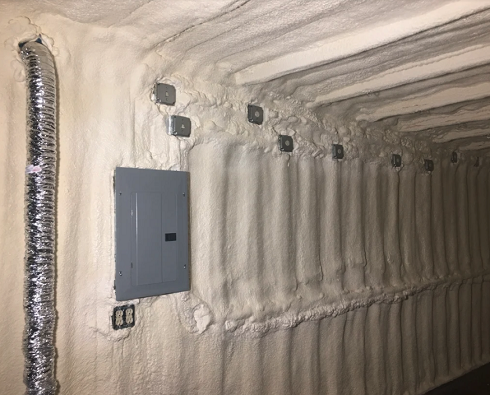Why Spray Foam Insulation
What is Spray Foam Insulation?
A really strong glue that holds the bones of the building structure together against dangerous weather, is why spray foam is becoming the preferred choice of insulation. This form of insulation is a spray-applied plastic that helps prevent bugs and/or rodents from getting inside your home. It also helps to reduce allergies, is a money saver in the long run, and even the application of the material is flexible with the design of your house or building.
Why Spray Foam Instead of Other Insulations?
01. Money Saver
Though it’s a little more expensive in the beginning, it will save you money on your energy bill in the long run. Other insulation types such as Fiberglass and Styrofoam come with inherent issues. Fiberglass eventually sags and bunches up while Styrofoam breaks over the years. With that said, spray foam insulation does not shrink or settle and it reduces overall energy consumption since it is long-lasting; there’s no need for a lot of new products. During the winter, the insulation protects you from the cold and moisture and in the summer, the insulation protects you from the heat.
02. Flexibility
This form of insulation makes it is easy for you to insulate a new building or update an old one! Because the application process and adhesion properties in this form of insulation is so flexible, it doesn’t take away from a ceiling design or any other places that might be visible.
03. Reduced Allergies
Spray foam reduces pollen and allergens that get through the tiny cracks and crevices of the building’s structure by restricting the amount of outside air that gets in.
04. Prevents bugs and/or rodents from getting inside
This form of insulation is well known for preventing bugs and small rodents from getting into your home through cracks and crevices. (Closed cell insulation works best for keeping out critters.)
There are three density types of spray foam insulation: high density, medium density, and low density. High density spray foam insulation is usually used for exterior and roofing applications; medium density spray foam insulation is usually used for continuous insulation, interior wall cavity fills and unvented attic applications; low density spray foam insulation, like the medium density, can also be used for interior wall cavity fills and unvented attic applications.
High pressure has both open cell insulation and closed cell insulation and can be used for larger projects.
Low pressures are offered in either open cell or closed cell which is used for smaller spray foam contracting jobs.

Open Cell vs Closed Cell Spray Foam Insulation
Open Cell Foam |
Using Both Open & Closed Cell Spray Foam |
Closed Cell Foam |
| Economical | Add to the sturdiness of the house because it is essentially filling any and all cracks | Denser |
| Blocks out more noise by itself unless mixed with a closed cell foam | Prevents moisture from getting through the walls, therefore it acts as a barrier against large quantities of water, ultimately protecting the inhabitants from growth of mold and mildew | Keeps more water and air out |
| Reduces high frequency noise | Reduces low frequency noise | |
| Not the best for small spaces | Can be used on craw space walls and other potentially moist environments, best for metal buildings, typically commercial/industrial | |
| Not best to be used in potentially wet areas | Can work in wet areas | |
| Best spray foam insulation for commercial buildings | Best for both residential & commercial buildings | Best spray foam insulation for residential buildings |
Eagle Insulation
ADDRESS:
278 Sawyer Drive #1
Durango, CO 81303
EMAIL:
robert@eagleinsulationco.com
PHONE: (970) 903-5040
Spray Foam Insulation
From Eagle Insulation